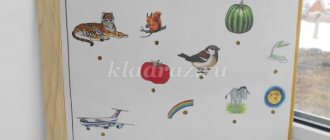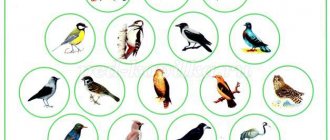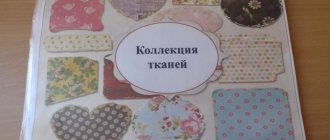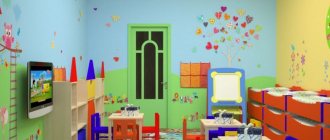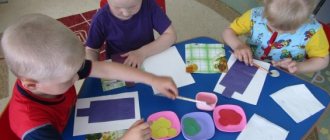The development of children's speech, attention, intellectual activity, intelligence, and creativity is influenced by the level of development of fine motor skills. This is very important, because thanks to this the child is able to perform many educational and everyday activities. You can develop finger motor skills in children using a do-it-yourself teaching aid for kindergarten. In other words - playing with the child. This is how attention, imagination, memory develop, experience is absorbed, habits and skills are developed.
It is very easy to make such a teaching aid with your own hands for kindergarten. A description of some of them can be found below.
“I want to touch everything”
This is a do-it-yourself didactic manual for kindergarten. The average group of kids will be interested in this game. It consists of 10 tactile cards with surfaces of different structures and numbers. With their help, sensory perception, mental potential in general, fine motor skills, memory develop, and children learn to count.
What you will need:
- cardboard;
- scissors;
- glue;
- numbers made of felt, velvet paper;
- various surfaces.
You can use sandpaper, wood, leather, felt, Velcro (the spiky part), and ribbons. Tactile cards are made of cardboard. A number and a piece of material with different surfaces are glued onto each one. You can make several sets, then there will be more variations of the game. For example, find identical ones, guess the surface by touch.
Interesting board games for children to develop speech
On store shelves we can find many board speech games for children. These are various “walkers”, and dominoes, and lotto, and various sound tracks, and cubes with letters or symbols. Which game to choose is up to you.
Board game “Luntik” for kids
In the assortment of children's stores you can find many board games, where the main characters are the heroes of your favorite cartoons.
My daughter really likes the cartoon about Luntik, so when we saw an educational game with cartoon characters, we immediately bought it. The 3D figures of the characters look original: Luntik, Bee, Mila and Kuzi, the house of Baba Kapa and Shershuli. The game includes a double-sided playing field. One side is for playing with letters.
To play with letters, the adventure game kit includes special cards with tasks
The second side of the game “Luntik” is intended for playing with numbers.
To play with numbers, additional task cards are not used
Now my daughter is three years old and we don’t know all the letters yet. Therefore, we play like this: we roll the dice, place (move) a chip on the dropped number and name the letter or number (depending on the field on which we are playing). This is how the game helps us quickly learn and remember letters and numbers.
Video: review of the action-adventure game “Luntik”
Photo gallery: board games for kids
With the help of games, kids learn to write stories, expand their vocabulary and develop logic.
The cards and cards included in the game promote speech development in children
The gaming educational set includes four full-fledged games
And when my son was little, now he is already 13 years old, we really loved to play with soft puzzles-rug with numbers and letters.
We used them to build a road, a house, boxes and much more. As we played, we named letters and numbers, and by the age of two, Zhenya already knew the entire alphabet. For example, when we were building something, I asked my little son: “Zhenya, please give me the letter “O” or the number “1.” So we quickly learned the alphabet.
“Place the pebbles in the houses”
The following do-it-yourself teaching aid for kindergarten will help you develop the ability to distinguish colors and name them correctly. The younger group is the target audience for training.
Materials: pebbles, colored cardboard, scissors, glue. Four boxes are made.
Game variations:
- count pebbles of a given color;
- arrange them in appropriate boxes.
The benefit of such a manual is the development of fine motor skills, children learning colors, and the ability to use their names in speech.
Where are teaching materials used?
The use of hand-made speech development aids for preschoolers creates a playful basis for working with them and determines the storyline of the lesson. A child, especially in the junior and middle groups of kindergarten, thinks concretely, using images, rather than abstract logical constructs. He can react to assignments received from a speech therapist or teacher, being a participant in a specific, albeit fictitious, situation. The teaching aids serve as the factual basis for their learning each year.
Speech development based on visual cues
When a child learns to express his thoughts, he must follow a certain pattern of expressing his thoughts. For a child who is almost unable to concentrate on one subject at his age, this is impossible. Using teaching aids in the form of cue cards helps build a story line. For younger children, we are talking about much simpler things. They simply have to name the objects or briefly describe the actions with the cue cards.
Speech therapist works with a child
For example, in the didactic manual “Zippers,” the child must choose among the open colored zippers lying on the table those that correspond to the teacher’s instructions and close them. At the same time, the child describes his choice, its reasons and the actions he takes.
At an older age, each visual cue can be used together with leading questions from the teacher and be the basis for a coherent story. This can be seen, for example, in classes devoted to professions.
Complex of articulatory gymnastics for children 2-3 years old
Every description of your actions, answer to a specific question, or short story based on visual cues helps your child better develop his speech skills. Serve as preparatory exercises for adult life.
Learning to retell
The development of coherent speech in children is one of the most important skills that a child must be taught. Without mastering it, he will not only not be able to develop properly intellectually, but also will not be able to fully socialize, not being able to conduct a dialogue or express his thoughts.
When retelling, the child must create a coherent, long story. However, for this he will need tips, which can be received during didactic games and from the teacher.
The development of fine motor skills plays an important role in this process.
Important! By engaging in retelling, you will be able to strengthen your speech and intellectual skills and increase the level of development of your personality.
Learning to think
Human speech is closely related to thinking. The same is true for a child. Communication is not limited to expressing your thoughts or describing actions. The level of speech proficiency is largely determined by the degree of development of the child’s personality and thinking.
Do-it-yourself teaching aids for kindergarten can be used not only for stories, but also as an excuse to ask your child questions about cause-and-effect relationships in the world around him. For example, using cards related to the plots of fairy tales, you can ask questions about the circumstances of the characters’ actions, the reasons and consequences of their actions.
You can combine the classes in question with the study of mathematics.
In addition, the educational function of speech development classes is important. For example, if a child is asked questions about the features and beneficial properties of the plants depicted in the pictures, then gradually this knowledge will be consolidated in the child. If additional questions are asked about this material, the child’s knowledge will become more detailed and practical.
Preparing for literacy
To do this, you need to learn not only oral speech, but also study letters and words. Children of senior preschool age, with the help of a teacher and parents, are able to master the alphabet and basic reading skills.
For this purpose, a do-it-yourself didactic manual on speech development for kindergarten with cards depicting letters, syllables or words can be used.
Picture 4 Speech corner
"Geocont"
You can make another teaching aid with your own hands for kindergarten. Mathematics assignments can be completed with its help. The game is a field (wooden) with multi-colored nails on which elastic bands are pulled.
Geocont is a constructor. On its field, using multi-colored rubber bands, you can make various geometric shapes, symmetrical and asymmetrical patterns. The game develops children's cognitive and sensory abilities, memory, speech, fine motor skills, imagination, spatial thinking, and teaches them to coordinate actions, compare, and analyze. At the moment of constructing geometric figures, preschoolers use tactile-tactile and sensory analyzers, which contribute to the formation of the concept of shape, elasticity (rubber bands stretch and return to their original position), immerse themselves in the world of geometry (learn what a “ray”, “straight line” is), segment", "point", "angle").
Geokont is a useful teaching aid. It’s not at all difficult to make it with your own hands for a kindergarten for the older group. However, even the little ones will find it interesting and educational to pull colorful rubber bands onto carnations.
"Seasons - dolls"
A do-it-yourself didactic manual for kindergarten based on the seasons can be entrusted to the parents of young children. It will help maintain attention and awaken interest in playing with dolls.
First, you need to explain to your parents the purpose, how all the elements will look, and also select the materials (cotton wool, fabric, thread, buttons).
So, how to make such a teaching aid with your own hands for kindergarten? The basis is four dolls, each of which is dressed in a sundress of the corresponding season - blue, green, orange, yellow. They have wreaths on their heads. Each doll holds a basket with items that correspond to the seasons. These can be flowers, boats, twigs, icicles, mushrooms, fruits.
It is easy to make such a teaching aid with your own hands for kindergarten. There are many guides on speech development, but this is one of the most effective. Also, the game “Seasons - Dolls” can be used in the visual arts and in children’s theatrical activities. The material is used according to the time of year.
The unusual, attractive appearance of the dolls encourages children to repeat individual words and phrases, and makes them want to listen carefully to what the teacher says. The manual is good for use in individual lessons with children. It perfectly promotes sensory development and helps reinforce the material. The teacher can use the dolls for entertainment, as a surprise during the holidays.
DIY didactic games for speech development
Yana Glebova
DIY didactic games for speech development
Educator: Glebova Ya. V
Preschool age is a period of active acquisition by a child of spoken language, the formation and development of all aspects of speech: phonetic, lexical, grammatical. The sooner learning the native language begins, the more freely the child will use it in the future.
Everyone knows that games have a general developmental effect on speech. The methodology includes various didactic games in which the tasks of activating and clarifying one or another grammatical form are solved, for example, helping children master the genitive plural, the imperative mood of the verb, the agreement of words in gender, ways of forming words (the names of baby animals, people of different professions, cognates). Games aimed at teaching children storytelling develop their ability to describe an object based on its main features (color, shape, size, actions; talk about an animal, a toy; compose a plot from a picture, develop it in accordance with the plan. The didactic task is clothed in gaming situations in which incentives for a coherent presentation of thoughts clearly appear. Thus, games and exercises solve in a complex all the tasks of speech development (education of sound culture of speech, formation of the grammatical structure of speech, vocabulary work, development of coherent speech).
Didactic games that have a complex impact on vocabulary, grammar, and coherence of speech should be interesting and exciting. I decided to make my own didactic manual for children of senior preschool age on speech development.
Didactic manual “Speech Transformer”
Target:
enrichment of active vocabulary, development of coherent, grammatically correct dialogical and monologue speech.
Description of the manual:
the desktop didactic manual is the author's development, intended for children of senior preschool age; consists of a base-stand and three replaceable blocks, each block contains a didactic game. The manual can be used in individual work with children, as well as in joint and independent activities.
1-BLOCK: Didactic game “Write your own fairy tale”
Target:
improve the ability to compose short fairy tales on a given topic “Once upon a time in the forest.”
Game description:
The child selects a block with a forest image, places it on a stand and secures it with an elastic band. The game comes with an envelope containing pictures depicting various fairy tale and cartoon characters. He is invited to compose his own fairy tale on the theme “Once upon a time in the forest”, and place several heroes on the panel; characters can be changed depending on the development of the plot. When choosing appropriate characters to tell, children give their descriptions and characteristics.
2-BLOCK: Didactic game: “Look and tell the story”
Target:
improve the ability to compose stories based on a set of pictures with sequentially developing action.
Game description:
the child selects a block with plot pictures, places it on the base of the stand and secures it with an elastic band. The paper film movement regulators are fixed at the top and bottom of the block; red arrows indicate the direction of movement. The child watches five stories with sequentially developing action and composes stories to choose from. Storytelling through a series of plot pictures develops in children the ability to develop a plot line, come up with a title for the story in accordance with the content, and connect individual sentences and parts of statements into a narrative text.
3-BLOCK: Didactic game “Magic Locker”
Target:
improve the ability to form nouns using the suffix protsa with the meaning of container
Game description:
The child selects a block with a picture of a store, places it on a stand base and secures it with an elastic band. The game comes with subject pictures: different products, a grocery cart, a boy, a girl.
Invite your child to “go to the grocery store.” Place pictures of products in a cart, name the products using sentences, for example: “I bought bread, I bought candy, etc., take the cart home. At home, put the purchased products in the “Magic Cabinet”, in which a piece of prostrate lives, and guess the name of the dish in which the products need to be placed. The child puts food in a cabinet and names, for example: the noun sugar - with the help of the suffix protsa forms a new word sugar bowl, etc. (sugar bowl, bread bowl, candy bowl, salad bowl, napkin bowl, pepper shaker).
"Sun"
It is very easy to make such a do-it-yourself teaching aid for kindergarten. Material:
- multi-colored cardboard;
- clothespins;
- scissors;
- markers.
You can cut out a sun, a hedgehog, a cloud. Clothespins are used as rays, thorns, raindrops, respectively. The game helps develop:
- finger motor skills;
- muscle strength;
- visual coordination.
All children will be happy to attach and remove clothespins.
"Locomotive"
Create this DIY visual teaching aid for kindergarten. The older group of kids will actively study it in their classes. The manual should be in a visible place so that children can approach it at any time, examine it, touch it, and play. The “passengers” of the locomotive change every week. It all depends on what topic the children are studying. These can be animals, vegetables, fruits, objects, professions, etc.
The manual will allow you to consolidate the material, develop the curiosity of children, enrich their vocabulary, diversify games, help develop thinking, and will be indispensable in training memory and logic.
Let's look at the progress of working with the didactic manual using an example.
- We put fruits and one vegetable in the train trailers. We ask the children the question: “What is unnecessary?”
- Kids must name the “passenger” fruits and summarize them in one word.
- "What's missing?" The game develops attention. The child turns away, the teacher removes one fruit, and the child names it.
- Orientation in space. We ask the child which fruit goes behind the pear, and which one goes in front of the banana, behind the apple, between the orange and the kiwi.
- "Mathematics". It is necessary to name the “passenger” of the second carriage, the last one, the first one. Plant an apple in the fifth, and a plum in the seventh. Name how many cars there are in total.
- The teacher describes a fruit without naming it. The child guesses. Then vice versa.
- “What kind of juice can be made from an apple?” Learning to form adjectives.
- Let's study colors. The teacher asks the child to plant only red fruits in the trailer.
Didactic games on traffic rules
Goal: — consolidation of children’s knowledge about various types of transport (passenger, cargo, passenger); traffic signs;
Objectives: Educational: 1. To form children’s ideas about various types of transport. 2. Consolidate knowledge about sensory standards of color. 3. Practice distinguishing objects by shape and size. 4. Familiarize children with a graphic representation of the letters of the alphabet. 5. Expansion of vocabulary. 6. Preparing the child for reading; learn letters, learn to read syllables; remember the sequence of letters of the alphabet; 7. Remember the emblems and names of cars. 8. Consolidate knowledge about traffic signs.
Developmental: 1. Develop concentration. 2. Develop visual and figurative thinking. 3. Develop the ability to combine objects based on certain characteristics (classification).
Educational: 1. Stimulate children’s ability to negotiate with each other about upcoming joint activities 2. Cultivate interest in the rules of behavior on the road.
"Dry aquarium"
This do-it-yourself didactic manual for kindergarten on speech development is a set of multi-colored pom-poms, which are collected in a box or plastic basin. This game normalizes muscle tone, stimulates tactile sensations, develops imagination, speech, and teaches color recognition.
The child puts his hands into the aquarium, sorts out the balls, lays them out, puts them back, squeezes and unclenches his hands. The value is that there is no fear of breaking anything. You can put toys at the bottom of the container and ask the child to find and get them.
What teaching aids can you make yourself for kindergarten?
Language development is not an isolated skill. To a large extent, it is determined by the general level of development of the child and, in particular, his intelligence.
Didactic manual on speech development
Activities that improve sensory and fine motor skills in children are of great importance in this process. For this, it is important to use teaching aids, a significant part of which can be made independently.
Children's learning, especially in junior and middle groups, should take place in a playful environment, otherwise they will lose interest in the subject and time will be wasted. For teaching to be effective, the teacher needs to use all available means to maintain the child’s useful activity.
Didactic materials for sensory development
The “Flower Petals” manual looks like this. A circle is attached perpendicularly to the straight stem. The edges of the central part are covered with Velcro. Several petals with images of objects or fairy-tale characters are offered. This fabric is also attached to the inner edge of each of them. The task is to find the petals with the corresponding words based on the letter drawn on the mug and attach them to the central part.
The game “Blow out the insects into the clearing” is designed to develop speech breathing. For this purpose, the “Polyanka” manual is used. It is a low box with high sides. Small cardboards with images of animals are suspended on short threads from the outside. The child must blow them out, but does not have the right to puff out his cheeks.
Important! In this way he is taught how to breathe correctly during a conversation.
The game "Clothespins" is made using the same manual. For this, the kids are given several colored clothespins and asked to build a fence. They place them on the edges, while loudly calling out the color used.
There are two horizontal lines of Velcro glued to the outer wall of the Polyanka manual. Each row contains four cards with images of animals, fairy-tale characters or objects. The child is told that in each row one of the pictures is extra and is asked to remove it. Then he should tell what the remaining images have in common and why.
Lesson with children
Iconic didactic materials
One of these multifunctional aids is “Teremok”. It is a fabric house attached to a flat, solid base. It has a large number of pockets sewn into it, in which various pictures are placed. They can depict objects of the surrounding world, fairy-tale characters from the fairy tale of the same name, images of letters or syllables.
Group lesson with a speech therapist in a preparatory group
There are various ways to use this manual in kindergarten.
Here's one of them. Children are shown pictures taken from a pocket attached to the tower. They ask what fairy tale this hero, who is depicted on the card, came from. The child must remember the name of the fairy tale and try to retell its content.
Important! If the child needs the help of a speech therapist, then it is provided. During the story, the teacher asks the child simple leading questions.
You can also use this manual in a preschool educational institution as follows:
- The teacher takes out cards showing the inhabitants of the tower, but does not show them. He depicts the sounds these animals make. The child must repeat them and name the hero of the fairy tale who is depicted on the card.
- The manual can be used to study prepositions that show the relative position of cards. The teacher places cards with pictures of animals in various pockets and asks questions about who is located where. The child must answer using the prepositions “above,” “under,” or “between.”
- Then the child is asked to formulate questions using the mentioned prepositions and ask them to the teacher.
Another task is the following:
- The child is given cards with images of fairy tale characters and asked to place them in various pockets.
- After this, the kid must say which animal lives on which floor and who is to the left, right, above or below him.
"Find a house for an egg"
This didactic manual, made with your own hands for kindergarten, will help the teacher:
- teach your child to distinguish and name colors correctly;
- develop the ability to combine a testicle and a cell;
- develop motor skills;
- act consistently.
To make it, you use a paper container, the cells of which are painted, and multi-colored capsules from Kinder surprises. It turns out to be a very colorful, bright guide.
While playing, children learn to find identical eggs and their corresponding cells, count, and arrange objects.
